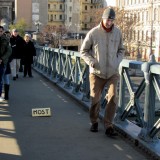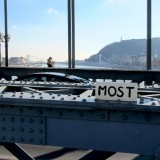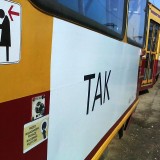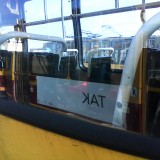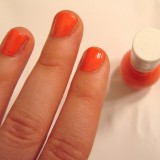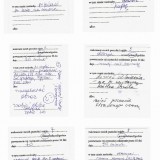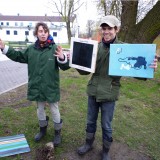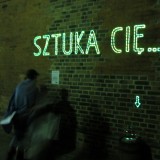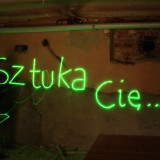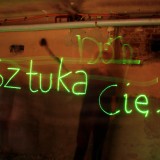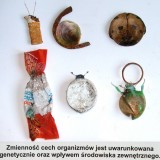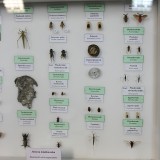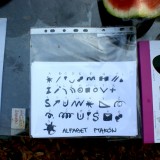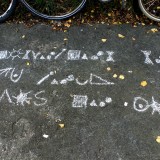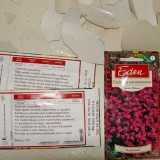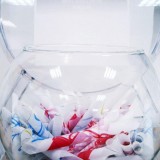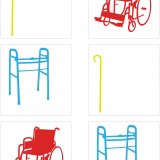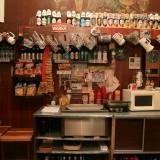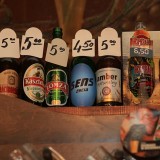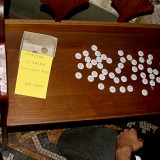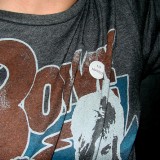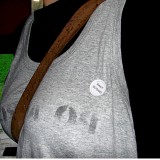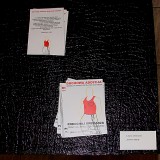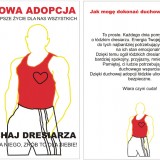Justyna Jakóbowska
Born in 1984, she is a graduate of the Department of Visual Arts within the Academy of Fine Arts in £ód¼. She expresses herself in the media of drawing, painting, installation, art action and intervention. She is also a curator and since 2009 has organised a curatorial project “Good and Beauty”. It focuses on discovering and conducting artistic actions in places which are typical relics of communist Poland, and which through their authenticity keep their specific poetics, for example the Anne Bar, a pierogi-bar, a shoe maker, a hairdresser. Justyna as part of Good and Beauty makes her own works and invites other artists to co-operate.
Justyna Jakóbowska is a sensitive observer of surrounding reality. On her blog she registers through her concise drawings made with a black stroke and intensive colour, what is happening to her, what she saw or what she thought about. The principle may bring associations with the Facebook question: “what’s on your mind?” Drawing notes, coloured by the artist’s mood or her state of mind, tell much more and are more interesting than photos, movies and comments uploaded by users of the social media. The drawings are a way to recognise and describe reality, an attempt to define the relationship between ourselves and our surroundings.
Apart from making notes upon the surrounding reality, Justyna also interferes in it. They are often petty, subtle interventions. The latest took place in November 2013 in Budapest. The artist while walking often on the famous chain bridge thought about the meaning of the word “bridge” which in Hungarian means “now”. In the middle of the bridge she placed a sheet of paper with the word which could be understood by both Poles and Hungarians, but in a different way. Similarities between the two nations seem to be something tenuous, which is shown by the language. However, being in a foreign country I was looking for the similarities with a great faith that mutual understanding is possible. – says the artist.
In 2010 she participated in Marcin Polak’s project Interpersonal Space for Communication as part of Fokus £ód¼ Biennale. The artists who took part in the project were supposed to devise a positive slogan, which then in the form of a sticker was placed upon one of the trams in operation around £ód¼. Justyna wrote the word: YES. Apparently positive, meaning affirmation, however it may express consent to cruel things, confirm a death sentence or violence. “Yes” is an instrumental word, a consent, it releases energy which may act in various ways. “Accidentally I registered a reflection of the word KAT (which means ‘executioner’ in Polish and is reversed from the Polish word TAK = YES). Maybe the reflection is an equally important element of the work just as the sticker itself.” – says the artist.
During the Festival Meat Culture in the Old Sewing Room in £ód¼ (2011) she suggested the viewers play Games for girls. Participants (mainly women) put on nail polish and she measured the time it took them to do it. Then she gave them a questionnaire asking how much time it took, how much time it would take through 10 days and what one could also have done during that time. This apparently light work was the result of the artist’s reflection over the reception of women in society, including herself. “I think that the Meat Culture is the culture in which we live, in which women are perceived as pieces of meat who should not only be tasty, but also decorated, aesthetically, tastefully looking. Hence the “art of makeup” – decorating meat, which does not serve any development. But why would meat develop?” These words sound like feminist statements from the 70s, and when said in 2011 by a young woman they prove that nothing has changed. And maybe even when faced with the endless possibilities of plastic surgery and the concentration of the usual side of pop culture on sexual imagery, they are more valid then before…
In Justyna’s works there also appears the theme of art, both in reference to the situation of debuting artists and a game with the notion of art itself. In her first performance Suuuuuuch art (2011) completed with Micha³ Fryc during the Festival of Ephemeral Art Temporarytacje, she referred to the place of young artists, who try to create. “It was an action which allowed us to distance ourselves from great names and great achievements in art, which weigh on every young artist. Also to distance ourselves from a belief that everything we do should be very important, be great art. Unfortunately it doesn’t seem like this to a young artist. “Suuuuuuuch art” one may say when one catches a big fish during vacation with an uncle. And during a performance” – commented the artist. (In Polish ‘art’ and a ‘piece’ is the same word). In 2012 during a Festival entitled “Happening” in Olsztyn and at the exhibition Express East. Return to Avant-Garde together with Justyna Aulak she did a light installation which lasted for 24 hours. The installation consisted of a lit sign “Art ….. you” which was part of a sentence with a performative element – from a vessel viewers drew pieces of paper with the rest of the sentence. The viewers were surprised to discover that all of them were saying the same: “will never betray”. It caused various reactions: laughter, confusion, discussions about the nature of art.
The artist is also sensitive to ecological problems. In the site specific work The changeability of organisms presented during the exhibition at the Festival of Science, Technology and Art in the Natural History Museum of the University in £ód¼ (2010) she placed her objects in display cabinets, between museum artefacts. The installation referred to the degradation of the natural environment and used the phenomenon of the adaptation by some organisms during the process of evolution to a look which would resemble more the environment. Justyna’s objects in the process of transformation was a bottle cap changing into a beetle, a candy wrap changing into a butterfly or a cigarette butt turning into a worm. Or maybe the process is taking place the other way round? A year earlier as part of the Intermedia Workshops I, here and now she caused mysterious plants to grow in the corners of an abandoned textile factory. In 2013 during the workshop organised by Sztuk-Pol she passed a message to people, written with the “birds’ alphabet” using a chalk on the ground saying: “It’s most beautiful here when you are away.” The work, as the artist says, “was created as a spontaneous reflection on the place in which the workshop took place (the area of £ód¼ Brewery), its strange fierceness in the very middle of the city and the moments when no one is there.” During the Festival of 4 Cultures in 2011 in the work entitled Mi³osz’s seeds she connected nature with poetry. Mi³osz’s seeds was a small packet with seeds on which the artist placed the poet’s poem about the garden. One could take the little packet with oneself and spread the seeds of poetry around.
In the work entitled Invisible (2013) in Veliko Tarnovo in Bulgaria, she paid attention to the problem of handicapped and old people. The artist did not treat it as a problem which refers to other people, as to all healthy and physically fit she gave an opportunity to draw a scarf with a pictogram representing 3 things, which can make you invisible: a wheelchair, a walking frame and a stick. “As a matter of fact one of them may be necessary for each of us sooner or later. Which one it’s up to fate” – says the artist.
She showed her reflection over human existence, especially with regard to conditions in Poland and £ód¼ in the works Sense of life, Spiritual adoption and Don’t take the name. As part of the action “Good and Beauty” 2013 between bottles of beer in the Anna Bar she placed her own with the label “Sense of life”. Inside there was real beer, and it was 50 groszy cheaper than the others so it was tempting to try it. The work is very expressive in the context of the inhabitants of the city centre of £ód¼. Even more ironic and radical was the work Spiritual adoption (exhibition Ja Lodzermensch, 2012), in which the artist suggested to the inhabitants to spiritually adopt a “tracksuit guy” (in Poland it’s the synonym of a hooligan). The artist noticed, that until the authorities take care of the problem of hooliganism and dysfunctional families, nothing is going to change and the inhabitants will not be safe. Now, as Jakóbowska’s leaflets say, we can start loving a ‘tracksuit guy’, think warmly about him, through which they become calmer and more friendly. Faith does miracles! In the action Don’t take the name during an exhibition in the Museum of Artistic Books Religion lesson in £od¼ she referred to exclamations very often repeated by Poles: Jesus Christ, Oh, Christ and Mary, Be afraid of God, For Hell’s Sake! Etc, which we use outside of religious contexts. The artist prepared pins with these sayings. She distributed them to people for “pay as much as you wish” (which was minimum 1 PLN and “God will repay you”).
Justyna appeared with her individual projects on the £ód¼ art scene in 2009. Since then she has actively participated in it as an artist and curator. Her art is worth observing and the works which she has completed so far prove that in subsequent years we can expect more interesting activities.
Anka Le¶niak
More at the artist’s blog:
http://jakoboska.blogspot.com/


